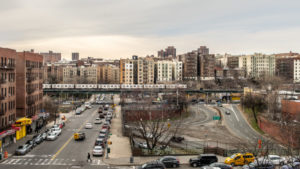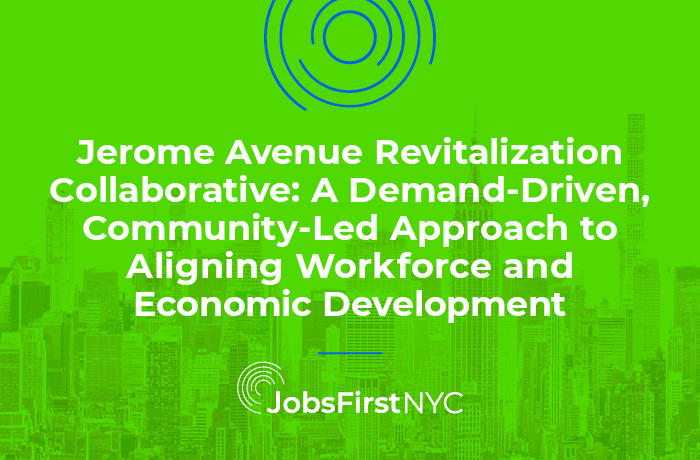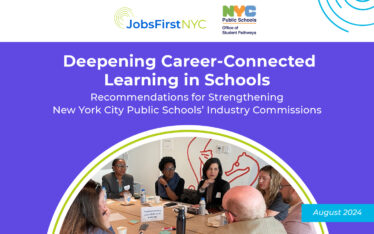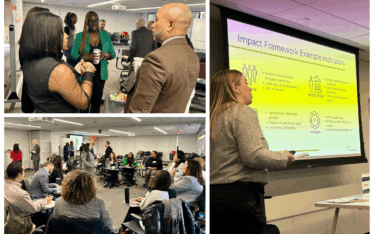The COVID-19 crisis has illuminated pre-existing disparities experienced by under-resourced communities that leave local businesses and residents at a disadvantage to be able to protect themselves, recover, and thrive. Historically, under-resourced communities—particularly communities of color—in the United States have been shortchanged by policies that have displaced and segregated them, creating significant barriers for socioeconomic advancement. These communities have experienced disproportionate levels of unemployment, underemployment, chronic health conditions, digital exclusion, housing and food insecurity, and financial risk—all of which are now being exacerbated by the COVID-19 pandemic.
This is especially true in the recently rezoned Jerome Avenue Corridor, which spans approximately 93 blocks across community districts 4, 5, and parts of 7 in the Bronx, New York. The neighborhoods of Concourse, Highbridge, Morris Heights, Mount Eden, University Heights, and Mount Hope encompass some 700 businesses and 93,000 residents. These residents and businesses have endured a host of long-standing structural barriers: for example, stubbornly high unemployment and poverty rates; a significant non-English-speaking population (17.3 percent of the residents do not speak English well while another 13 percent do not speak English at all); and, low levels of educational attainment (62 percent with less than a high school diploma). Before the current pandemic, about a fourth of young adults in these neighborhoods were out-of-school and out-of-work (OSOW), with nearly 40 percent of young adults living in poverty.
In response to these longstanding structural barriers and the recent rezoning, JobsFirstNYC has been working with the Jerome Avenue Corridor community to ensure that local residents and businesses are positioned to collectively leverage new and existing opportunities resulting from the rezoning. JobsFirstNYC—in partnership with the Children’s Aid Society’s Bronx Impact, a part of the Empire State Poverty Reduction Initiative—was invited by community stakeholders to develop a plan and build the infrastructure necessary to benefit from incoming economic development.
Businesses along the Jerome Avenue Corridor—which are primarily small, minority, and women-owned businesses—are at constant risk of displacement. All incoming economic development efforts should take note of these realities and strive to mitigate displacement, strengthen local minority- and women-owned businesses, create quality and better-paying jobs, and prepare local residents to access those jobs. To do this, a coordinated infrastructure of community stakeholders is needed to help ensure accountability for the commitments made by New York City and that incoming investments improve the economic well-being of local residents and businesses.
In New York City, rezonings are implemented through a tool known as the Uniform Land Use Review Procedure, a process where the final decision lies with the community board and local city council members. Each rezoning plan involves a multistage process that can take years—and once completed, it sets the stage for redefining the value of the land by assigning new codes that determine what can be built and operated there. Rezoning initiatives have the potential to increase the land value in a given area by attracting new investments and creating more sites for housing, public spaces, businesses, and jobs.

A view from the Grand Concourse of Jerome Avenue
Depending on who you ask, rezonings can bring promising economic opportunities to the community or they can mean residents are displaced and small businesses are priced-out. For city government officials, rezonings can mean taking “underutilized” land to attract private investment and businesses and to spark economic development in communities that have been historically excluded from the City’s thriving economic life. For real estate developers, rezonings can mean tax incentives that allow them to build housing and commercial and mixed-use spaces at a competitive rate. But for local residents and small businesses, these initiatives may result in rent hikes, displacement, and gentrification, which ultimately can lead to even greater financial insecurity in the targeted communities. Thus, to ensure that the needs and interests of all stakeholders are met and that rezonings do not benefit at the expense of others, it is critical that elected officials, government agencies and real estate developers work hand in hand with the local community (including community organizations, educational institutions, and businesses) to break down systemic barriers and expand access economic opportunities.
Responding to the need to align incoming economic investment to workforce development, JobsFirstNYC has collaborated with a diverse group of stakeholders to create the Jerome Avenue Revitalization Collaborative (JARC), an economic and workforce development community solution designed through JobsFirstNYC’s community-driven, demand-led innovation process. The process of creating JARC includes input from housing and economic development institutions, city agencies, small businesses, business associations and chamber, local community development finance institution (CDFI), business networks, advocates, community boards, workforce development organizations, residents (non-institution affiliated), and local community colleges. JARC is working to define the current challenges job seekers and employers are facing in the corridor, identify assets within the community, and position itself as a key player in ensuring that the rezoning effort achieves accountability and results. Using JobsFirstNYC’s five-phase innovation process—investigate, imagine, incubate, implement, and integrate—the JARC’s aim is to increase economic opportunity in the Jerome Avenue Corridor by preparing current employers, workers and residents for potential zoning-related impact, increasing the educational and employment attainment of local residents, and advocating for a greater diversity of current and future businesses and employers.
Set to officially launch in the summer of 2020, this collaborative will embark on a three-pronged strategy to ensure that the Jerome Avenue Corridor rezoning effort leads to inclusive economic growth and sustainability for local residents, businesses and workers impacted by the Jerome Avenue rezoning. This includes:
- An employer-facing network that will provide residents with direct referrals to jobs available through the JARC’s agreements with real estate developers, employers, and other partners.
- A virtual and a brick-and-mortar business hub that will provide local business owners and employers with access to business development resources made available through the JARC’s agreements with City agencies and other partners.
- Connecting low-income residents to grants and financial support to pay for educational or workforce development training that they would otherwise not be able to afford.
Through its collaborative approach, the JARC seeks to ensure that the Jerome Avenue Corridor rezoning initiative fulfills its commitments and has a positive impact for local stakeholders. Aligning workforce and economic development investments in a coordinated way through cross-sector collaborations should be required of all rezoning initiatives. Doing so will create opportunities for those who are historically disenfranchised to participate in shaping incoming economic development and can help put communities on a path to economic revitalization.
The effort is supported, in part, through the Children’s Aid Society’s Bronx Impact, an Empire State Reduction Initiative, the Altman Foundation, JPMorgan Chase Foundation, Ira W. DeCamp Foundation and the MUFG Union Bank Foundation.




